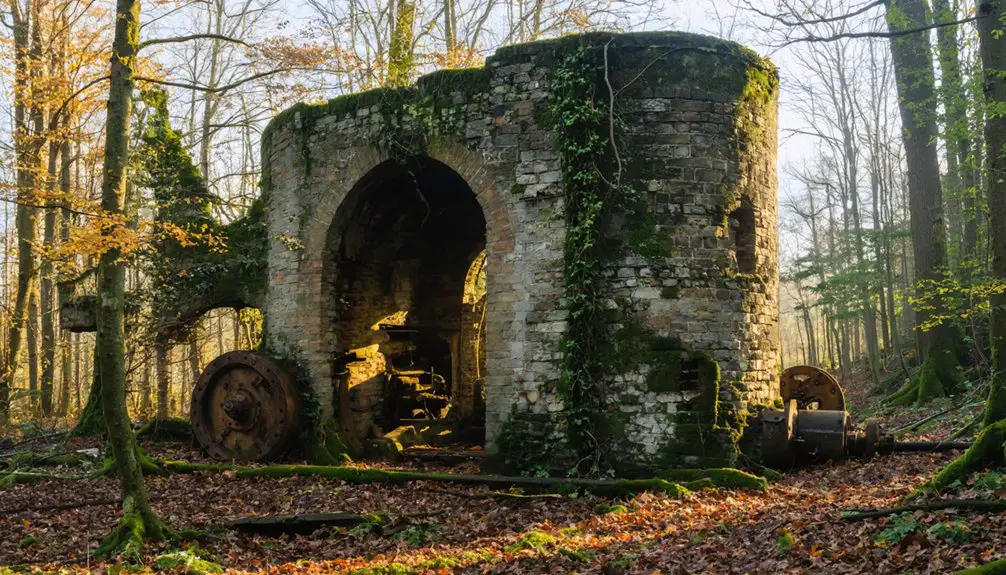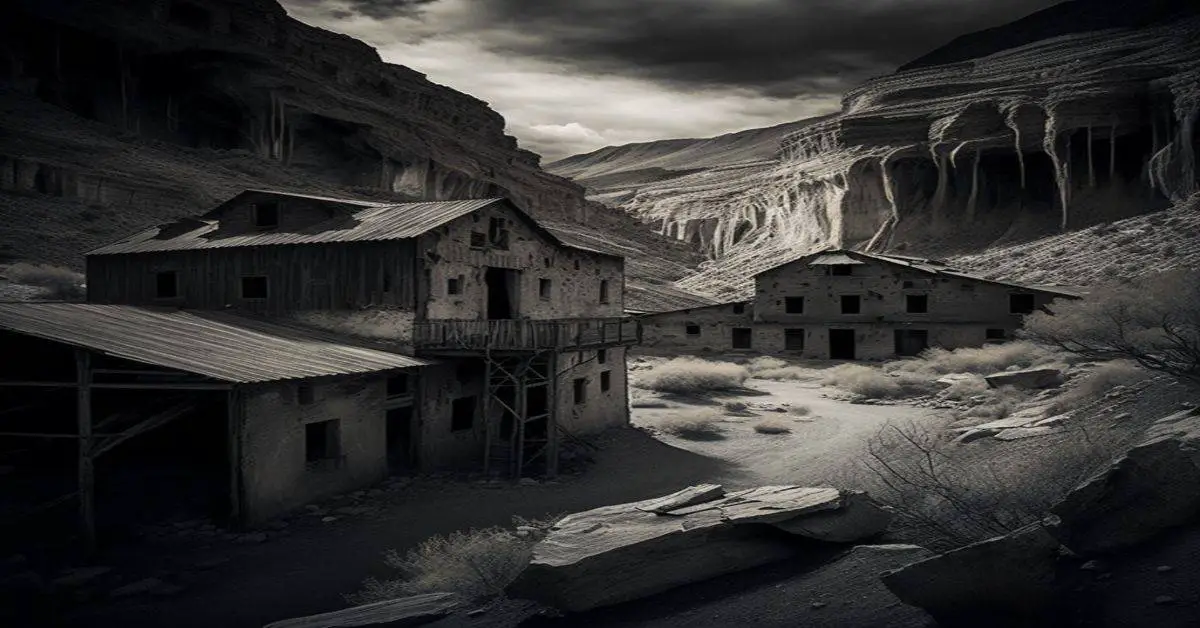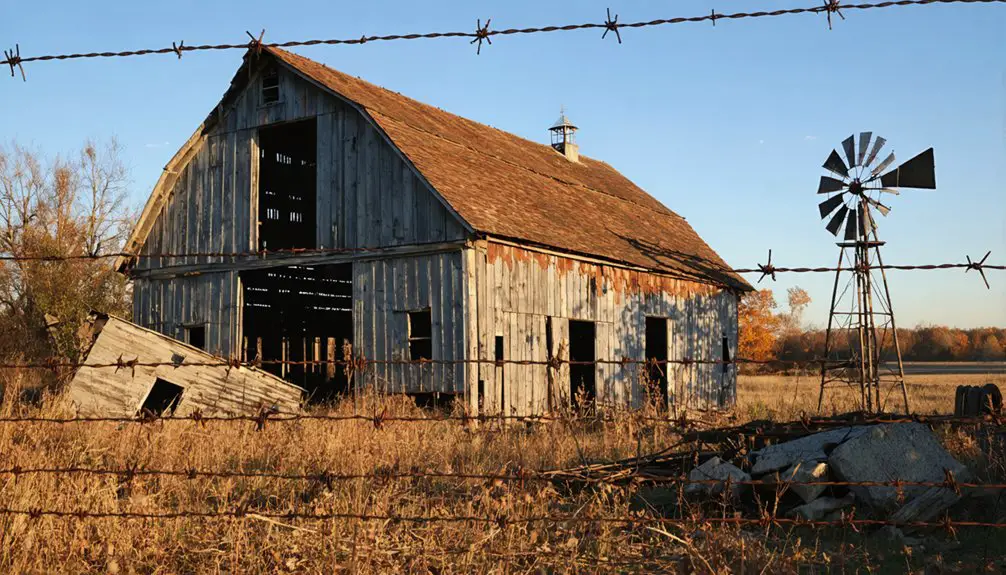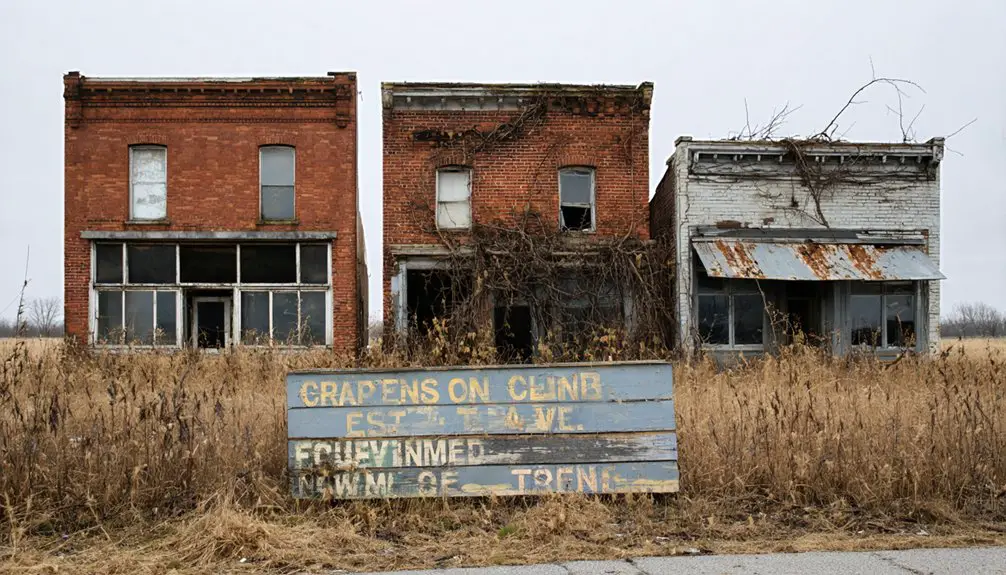You’ll find Vinton Furnace‘s abandoned industrial ruins in Ohio’s historic Hanging Rock Iron Region. Founded in 1854, this iron-producing powerhouse once churned out 3,100 tons annually using charcoal technology before upgrading to coal coke in 1875. The site features rare Belgian coke ovens, worker housing remnants, and a blast furnace, all accessible via the 5.6-mile Pine Run Trail. Beyond the visible ruins lies a rich tapestry of ghost stories and local legends.
Key Takeaways
- Vinton Furnace operated from 1854 to 1883 in Ohio’s Hanging Rock Iron Region before becoming a ghost town due to economic challenges.
- The abandoned site features 17 surviving Belgian coke ovens and industrial ruins accessible via the 5.6-mile Pine Run Trail.
- Company-built worker housing and community structures once surrounded the furnace but were abandoned after the facility’s closure.
- The area is now part of Vinton Furnace State Forest, with historic ruins and industrial remnants marking the former iron-producing community.
- Local ghost stories and legends, including sightings at nearby Moonville Tunnel, reflect the area’s dangerous industrial past and isolation.
The Rise and Fall of an Iron Empire
While iron production thrived throughout Ohio’s Hanging Rock Iron Region in the mid-1800s, Vinton Furnace emerged as a significant contributor when it began operations in 1854.
The Vinton Furnace stood among many iron operations in Ohio’s Hanging Rock region, marking its place in industrial history since 1854.
Founded by Clark and Culbertson, the furnace demonstrated early success with its twelve-ton daily capacity.
You’ll find evidence of industrial innovation in its early days, as the furnace produced 3,100 tons of foundry iron annually using charcoal-fired technology. The original stack measured 11 feet across and provided the foundation for early production success.
The operation’s economic resilience showed when it shifted to coal coke fuel around 1875, installing 24 unique Belgian coke ovens and upgrading to a modernized 50-foot stack capable of producing 20 tons daily.
Despite these improvements, challenges mounted. The local Quakertown coal’s high sulfur content proved unsuitable, timber for charcoal grew scarce, and workers earned meager wages of 65 cents per 12-hour day, leading to the furnace’s closure by 1883.
Life in a 19th Century Industrial Community
In Vinton Furnace‘s bustling industrial community, you’d find workers rising before dawn to begin their physically demanding shifts at the iron furnace, while their families maintained homes in the company-provided housing clustered near the workplace.
The company offered cooperative store benefits to help workers support their families, mirroring successful industrial operations like the Jeffrey Manufacturing Company in Columbus.
You’d notice the rhythms of daily life revolving around the furnace’s operations, with workers gathering at the company store and cafeteria during breaks, and women managing household duties that supported the workforce.
After long workdays, you’d see residents congregating at local establishments or ethnic social clubs, where immigrant workers preserved their cultural traditions while forging new bonds within the industrial community. The German immigrants were particularly influential in shaping these social spaces, bringing their traditions and work ethic from their homeland.
Daily Worker Routines
Life for industrial workers in Vinton Furnace began harshly each morning as factory whistles pierced the dawn air at 6 am, jolting laborers from their brief rest.
You’d hurry through a quick breakfast before rushing to the workday structure that would consume the next 12 to 14 hours of your life. Labor discipline was ruthlessly enforced – you couldn’t sit, rest, or even pause as machines dictated your pace. Workers often had to eat their meager meals on the factory floor while continuing to work.
Standing through your entire shift, you’d battle exhaustion while operating dangerous machinery in poorly ventilated spaces. Workers frequently suffered from severe lung diseases due to the constant inhalation of industrial particles floating through the air.
Overseers maintained strict control through beatings and harsh punishment for any mistakes or slowdowns.
After your shift ended, you’d still face household chores before collapsing into bed, knowing tomorrow would bring another grueling cycle of industrial servitude.
Housing and Community Structure
The stark realities of daily labor were matched by the austere living conditions in Vinton Furnace’s company-controlled housing system.
Worker housing consisted of timber-frame structures built from locally harvested old-growth forests, with variations reflecting workers’ economic status. You’d find the community layout centered around the furnace operations, where company-built cottages housed workers and their families. The industrial complex employed four to nine men for its coal processing and coke production operations. Workers earned as little as 65 cents per day for their grueling labor at the furnaces.
Key features of the community structure included:
- Company stores where you’d exchange scrip wages for essential goods at inflated prices
- Multi-room cottages clustered near furnace sites, with stone foundations still visible today
- Basic infrastructure including roads and rail connections, though amenities were limited
The furnace companies owned most local property, controlling not just housing but the entire landscape where you lived and worked.
Social Gathering Traditions
Despite the grueling 12-hour workdays at Vinton Furnace, residents carved out meaningful social connections through a rich tapestry of communal gatherings.
You’d find workers and their families coming together at communal picnics, seasonal fairs, and informal celebrations marking the end of production cycles. The company store, while controlling workers through scrip payment, served as an essential social hub where you could exchange news and build relationships with neighbors.
Your social calendar would’ve included church services that doubled as community gatherings, along with dances and festivities that brought together diverse immigrant groups.
If you’d faced hardship, mutual aid networks provided significant support. In the evenings, you might’ve joined others at local taverns, sharing stories and preserving cultural traditions through music and folklore.
Belgian Coke Ovens: A Unique Industrial Legacy
Manufactured in Belgium and shipped brick-by-brick to Ohio, Vinton Furnace’s Belgian coke ovens stand as possibly the world’s last remaining battery of their kind.
These rare Belgian coke ovens, meticulously transported across an ocean to Ohio, survive as the last of their industrial lineage.
Originally consisting of 24 ovens, these industrial relics were essential to the furnace’s shift from charcoal to coke production in 1875. You’ll find 17 ovens still standing today within Vinton Furnace State Forest, though they’re battling nature’s slow reclamation. Each brick used in construction was carefully numbered for reassembly once transported.
- The ovens enabled daily iron production of up to 30 tons when both furnaces were operational
- Local coal’s high sulfur content forced the operation to import railroad coal for proper coke production
- You can explore these historic ruins via a 5.6-mile round-trip hike on Pine Run Trail
Despite preservation challenges from vegetation growth, these rare ovens represent a fascinating chapter of American industrial innovation and European technological transfer.
Environmental Transformation Through Time
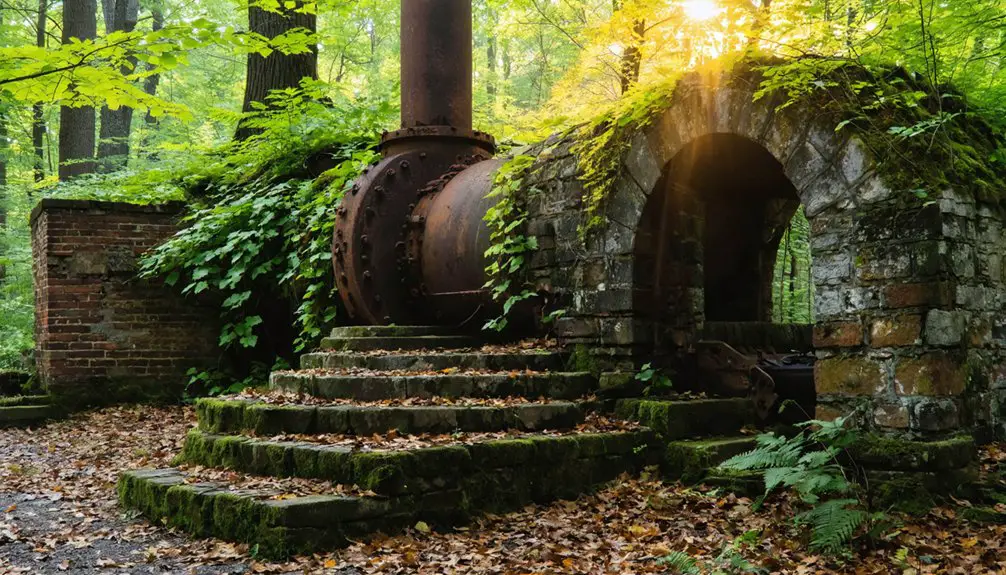
During its operational peak from 1854 to 1883, Vinton Furnace’s iron production dramatically transformed the surrounding landscape.
You’ll find that round-the-clock tree harvesting for charcoal stripped vast woodland areas bare, disrupting wildlife habitats and local ecosystems.
The ecological impacts intensified as workers extracted sandstone, mined iron ore, and built railways across the terrain. The furnace’s impressive output of 3,100 tons of iron in 1857 required extensive resource consumption that further altered the natural environment.
Ghost Stories and Local Legends
Beyond the physical remnants of Vinton Furnace’s industrial past, a rich tapestry of supernatural tales and local legends has emerged from the area’s shadowy history.
You’ll find stories of ghostly sightings at nearby Lake Hope Furnace, where a watchman struck by lightning continues his eternal rounds during storms.
The region’s most famous eerie encounters occur at Moonville Tunnel, drawing paranormal investigators worldwide.
- A tall bearded man with fiery eyes appears carrying a glowing lantern near the tunnel
- The Lavender Lady, killed on a nearby bridge, leaves behind her signature scent
- “Baldy” Keeton’s restless spirit pelts visitors with pebbles at the tunnel entrance
These haunting tales reflect the area’s dangerous past, where industrial accidents, disease, and isolation created perfect conditions for enduring ghost stories.
Exploring the Ruins Today
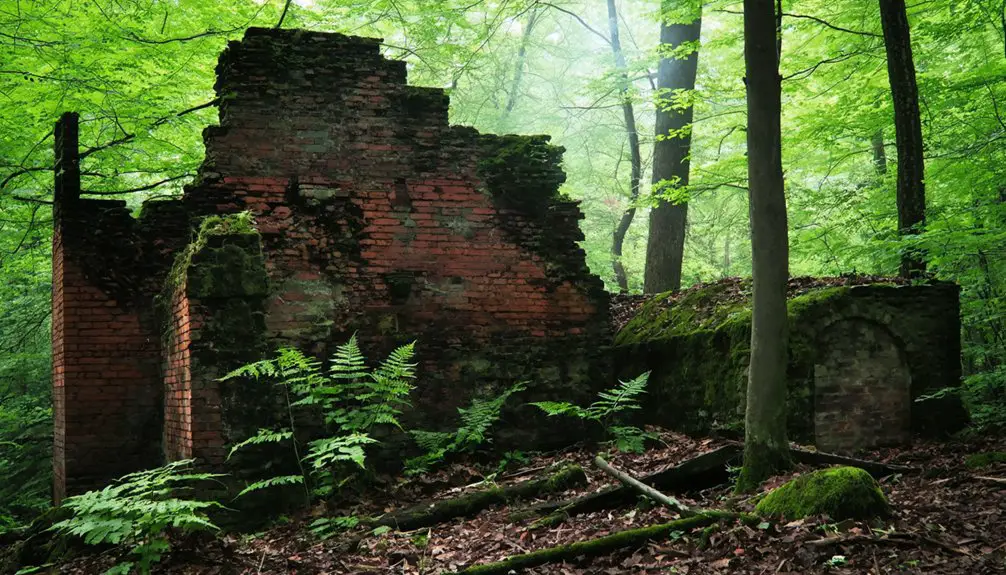
Hidden within the Vinton Furnace State Experimental Forest near Albany, Ohio, the historic Vinton Furnace ruins offer an adventurous exploration opportunity for history enthusiasts.
To begin your ruins exploration, you’ll park at the gated entrance on Experimental Forest Road and follow Pine Run Trail. You’ll encounter footbridges crossing Elk Fork – watch your step, as they’re weathered.
The natural surface trail’s switchbacks lead you to the impressive blast furnace ruins and Belgian Coke Ovens, both constructed from local sandstone in the 1850s.
While historical preservation efforts are minimal, you can still examine the furnace’s truncated pyramid shape and exposed firebrick lining.
Look for old medallions on trees marking the original pathways, but stay clear of barricaded areas – they’re blocked for your safety.
Frequently Asked Questions
What Was the Average Monthly Wage for Workers at Vinton Furnace?
Like chained birds in a gilded cage, you’d earn about $10 monthly for grueling 12-hour shifts under harsh labor conditions, with wages paid in company scrip, highlighting the severe wage disparity.
Were There Any Major Industrial Accidents During the Furnace’s Operation?
You won’t find any documented major industrial accidents or verified safety incidents, as historical accident reports from this period are missing or weren’t maintained during the furnace’s 1854-1883 operation.
How Many People Lived in Vinton Furnace During Its Peak?
While you’d expect detailed records for such an industrial hub, population demographics weren’t well documented. Community dynamics suggest several hundred people lived there during peak operations, based on worker housing patterns.
What Happened to the Residents After the Furnace Closed?
You’ll find that residents faced severe economic migration as jobs vanished. Workers scattered to nearby towns like Wilkesville and Dundas, while community decline led many to seek opportunities in industrial centers.
Were There Any Churches or Schools Built for the Community?
Through the misty ruins of time, you won’t find evidence of churches or schools built directly in the community. Historical records don’t show any established community facilities during the furnace’s industrial heyday.
References
- https://visitvintoncounty.org/what-to-do/paranormal-investigation/
- https://ohiodnr.gov/wps/portal/gov/odnr/go-and-do/plan-a-visit/find-a-property/belgian-coke-oven-ruins
- http://www.oldeforester.com/Vinton.htm
- https://ohioghosttowns.org/top-10-ghost-towns/
- https://blogs.bgsu.edu/elements/2012/03/02/moonville-a-journey-to-the-past/
- http://www.selindberg.com/2021/07/belgian-coke-oven-and-vinton-furnace.html
- https://ohiogenealogyexpress.com/vinton/vintonco_hist_1916/vintonco_hist_1916_chptIII_ind_rr.htm
- https://visitvintoncounty.org/history/iron-production-in-vinton-county/
- https://www.teachingcolumbus.org/industrialization-and-progressivism1.html
- https://cincinnatithought.com/a-semi-brief-history-of-the-cincinnatian-industrial-revolution/
